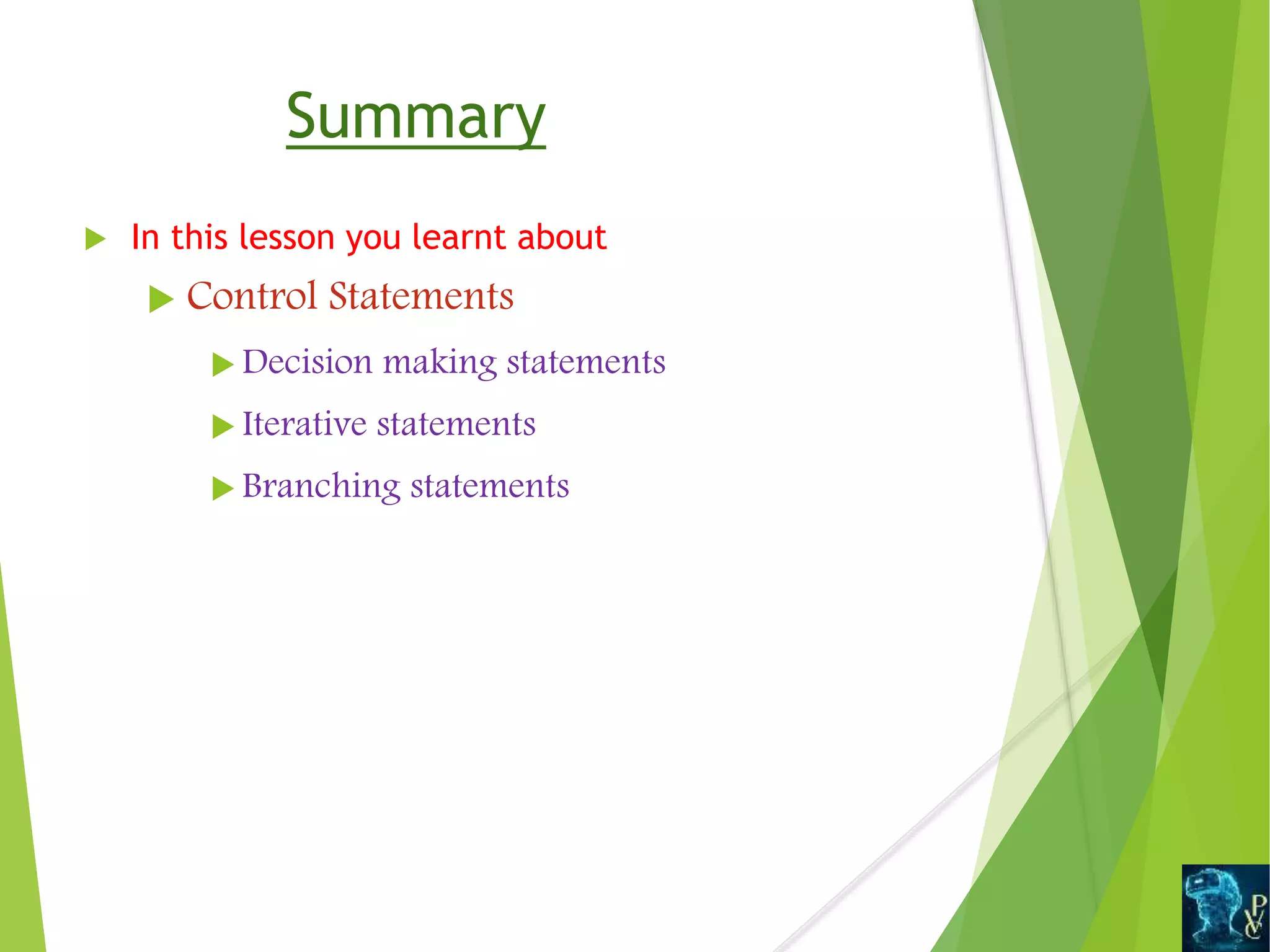This document discusses Java control statements, which are essential for managing the flow of a program through decision-making, looping, and branching. It covers categories such as selection statements (if, if-else, switch-case), looping statements (for, while, do-while), and jump statements (break, continue). Each type, along with examples, illustrates how to implement and utilize these control structures in Java programming.

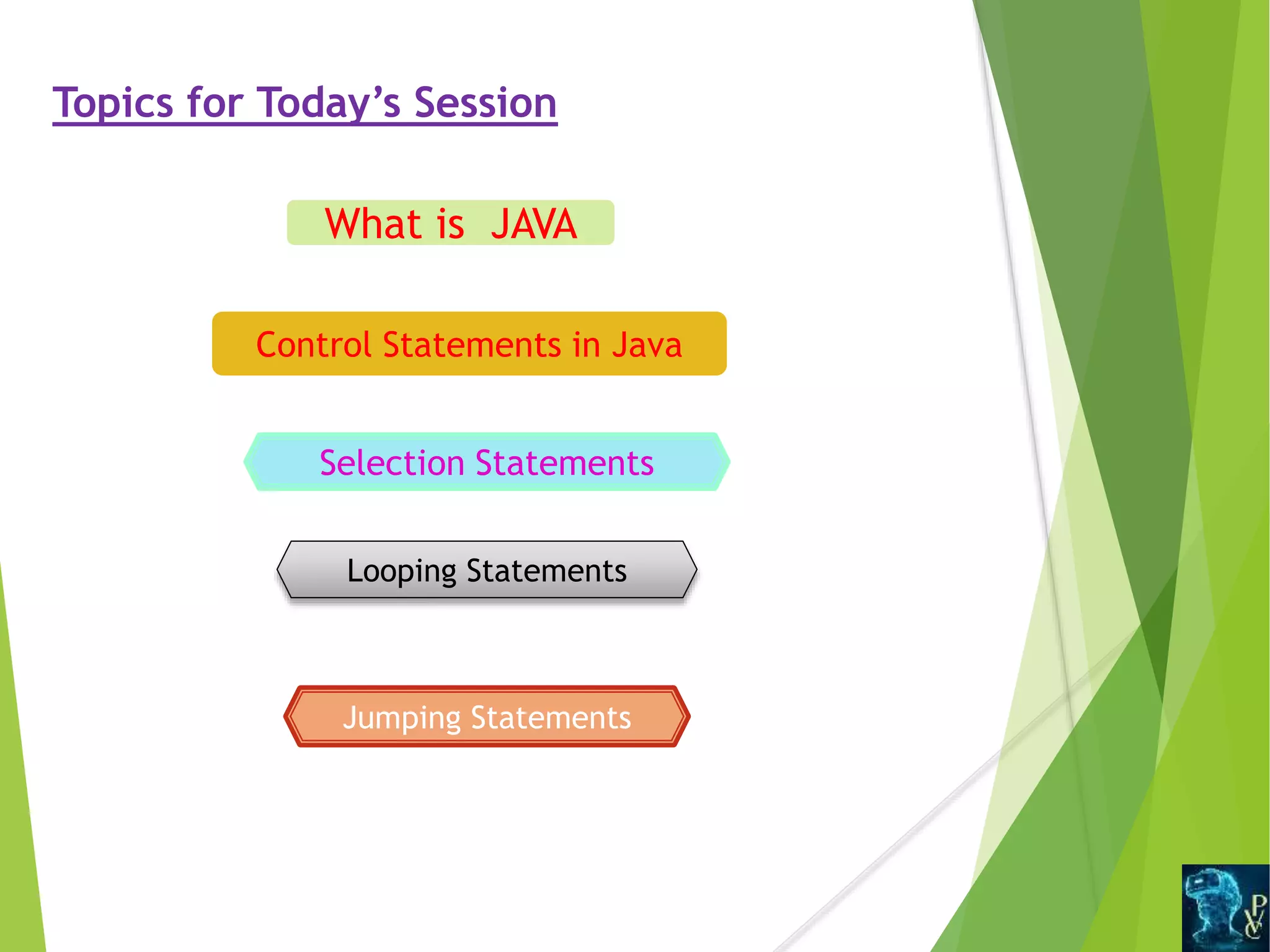
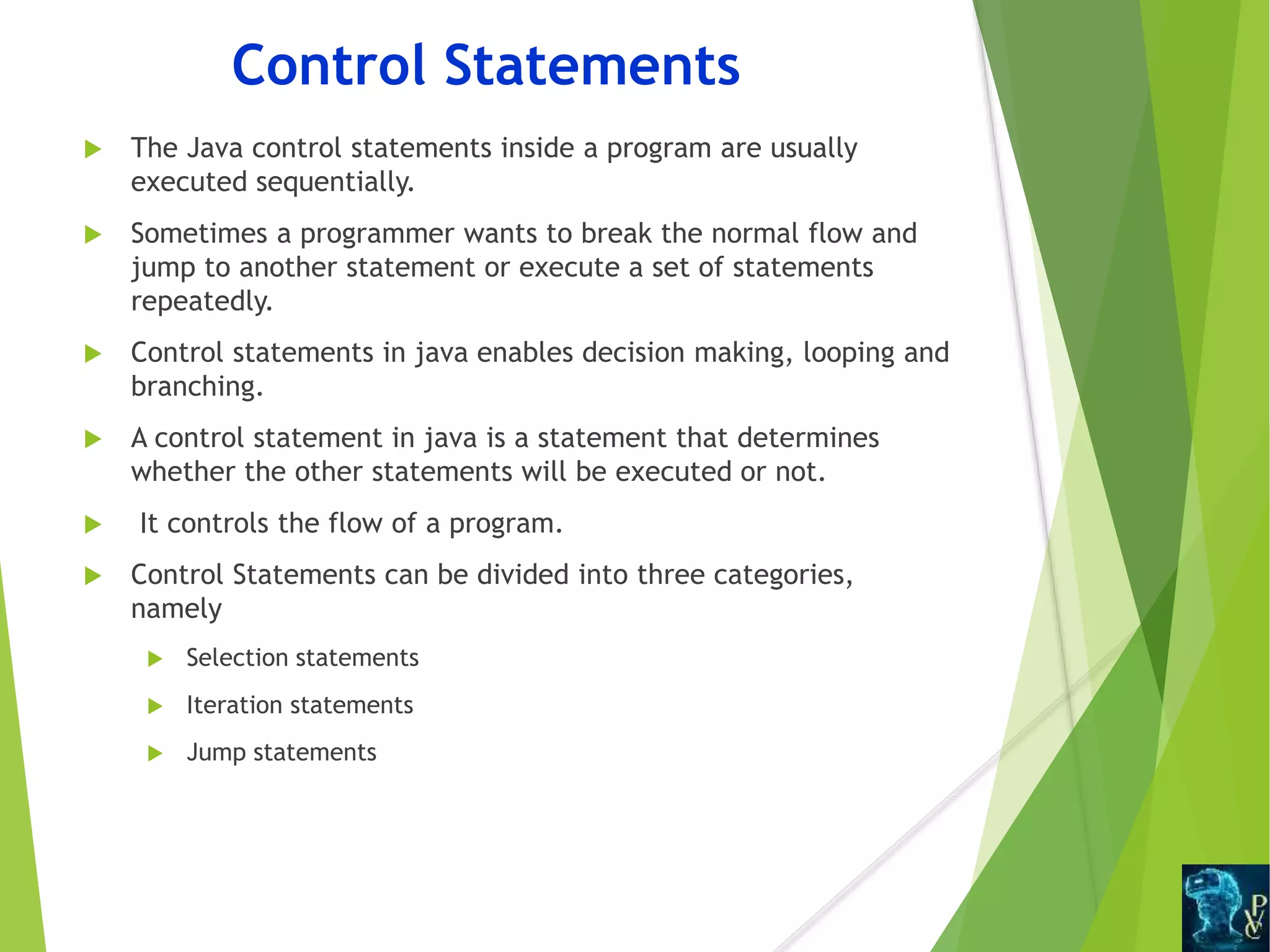
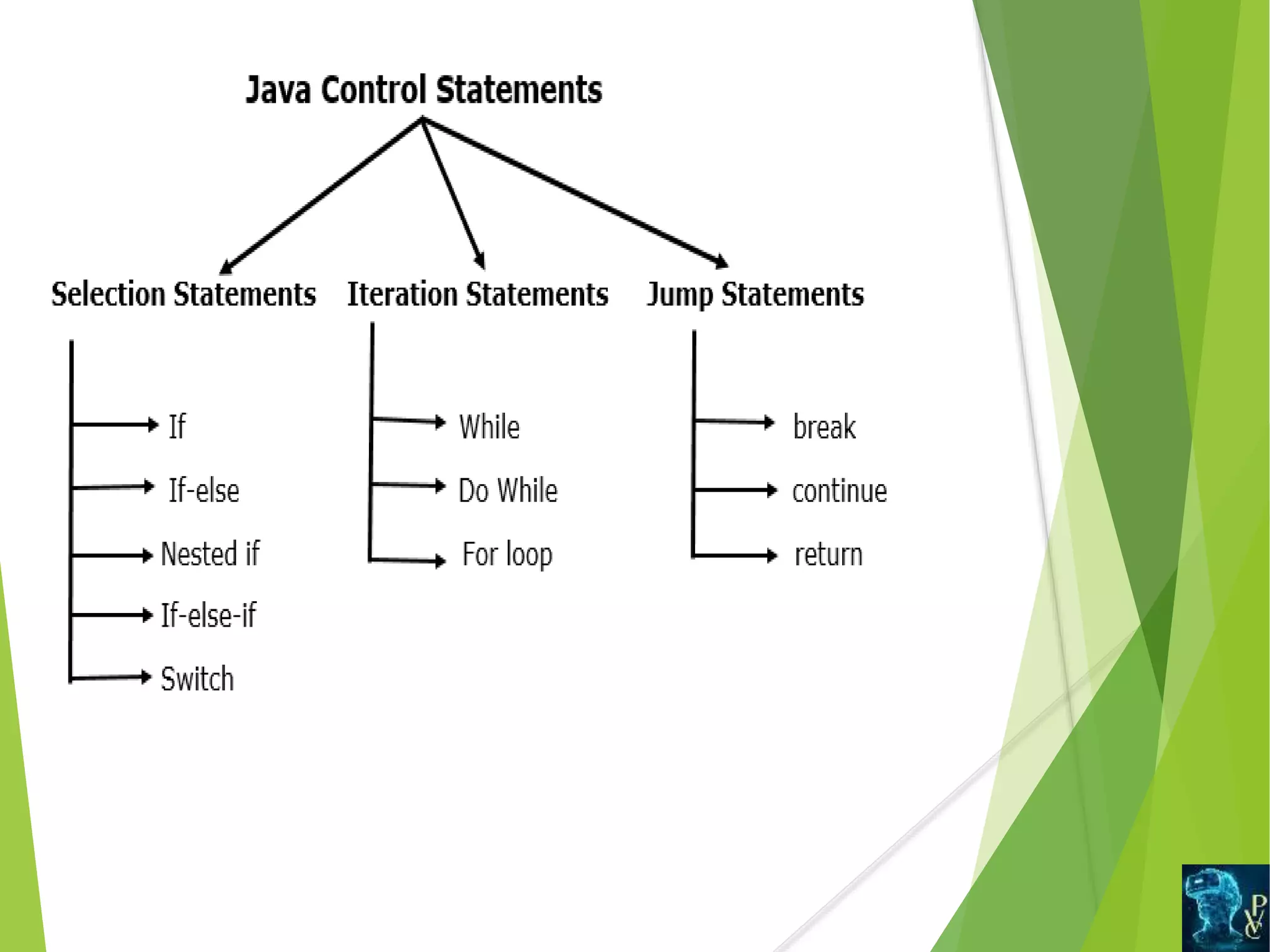
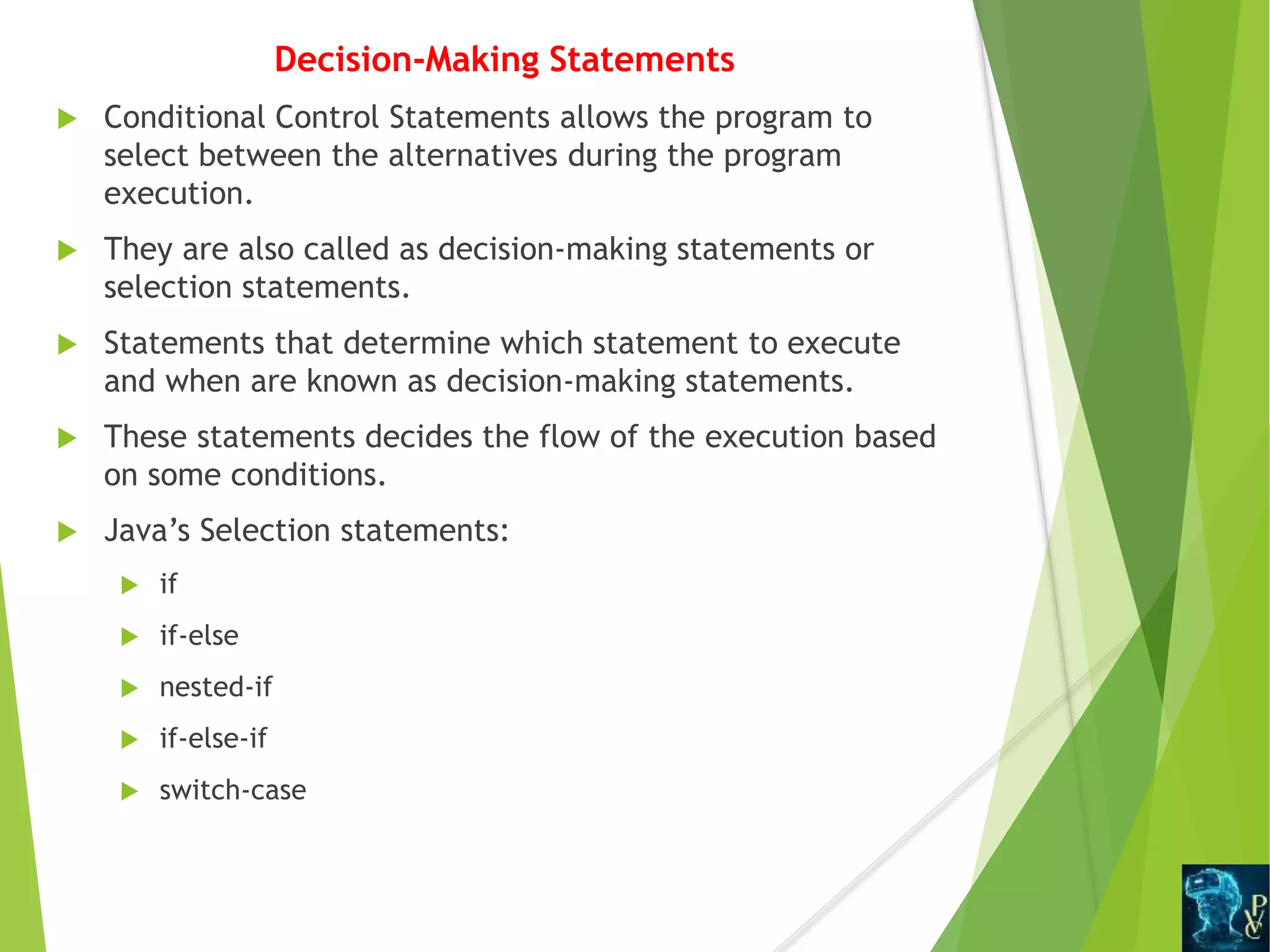
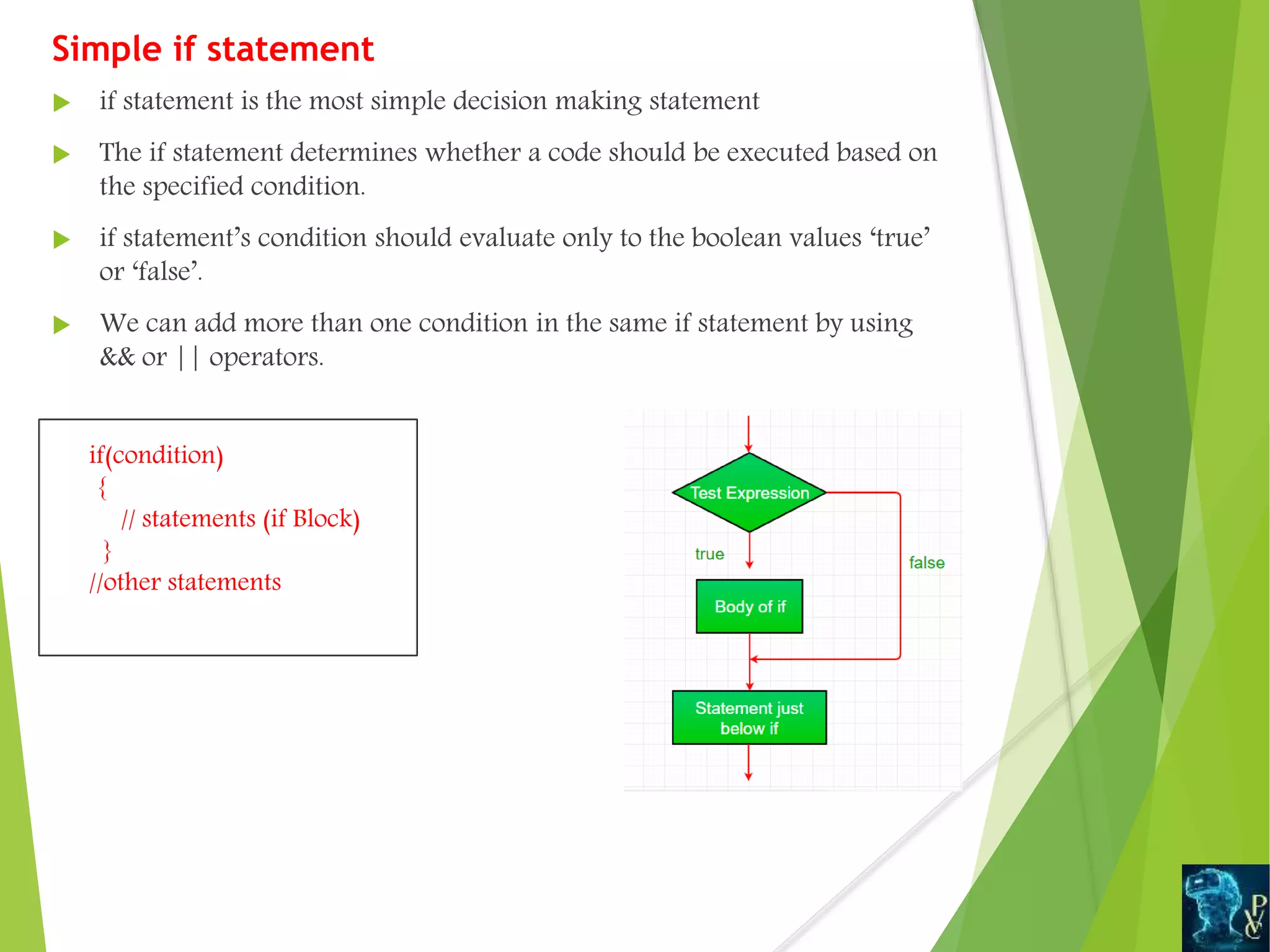
![class IfDemo1 {
public static void main(String[] args)
{
int marks=70;
if(marks > 65)
{
System.out.print("Hello Java! Am in If");
}
}
}
if-then -else Statement
The if-else statement is used for testing conditions.
It is used for true as well as for false condition.
If then Else statement provides two paths.
The if block is executed when the condition holds true.
When the condition evaluates to false, the statements inside
the else block are executed.](https://image.slidesharecdn.com/controlstmtsinjava-201023155146/75/Control-statements-in-java-7-2048.jpg)
![if (condition)
{
// Executes this block if
// condition is true
}
else
{
// Executes this block if
// condition is false
}
contd..
// Java program to illustrate if-else statement
class IfElseDemo {
public static void main(String args[])
{
int i = 20;
if (i < 45)
System.out.println("i is smaller than 45");
else
System.out.println("i is greater than 55");
}
}](https://image.slidesharecdn.com/controlstmtsinjava-201023155146/75/Control-statements-in-java-8-2048.jpg)
![Nested if statement
An if present inside an if block is known as a nested if block.
It is similar to an if..else statement, except they are defined inside another
if..else statement.
contd..
if (condition1)
{
// Executes when condition1 is true
if (condition2)
{
// Executes when condition2 is true
}
}
class NestedIfDemo {
public static void main(String args[]) {
int s = 15;
if (s > 30)
{ if (s%2==0)
System.out.println("s is an even number and greater than 30!");
else
System.out.println("s is a odd number and greater than 30!"); }
else {
System.out.println("s is less than 15"); }
System.out.println("Hello World!");
} }](https://image.slidesharecdn.com/controlstmtsinjava-201023155146/75/Control-statements-in-java-9-2048.jpg)
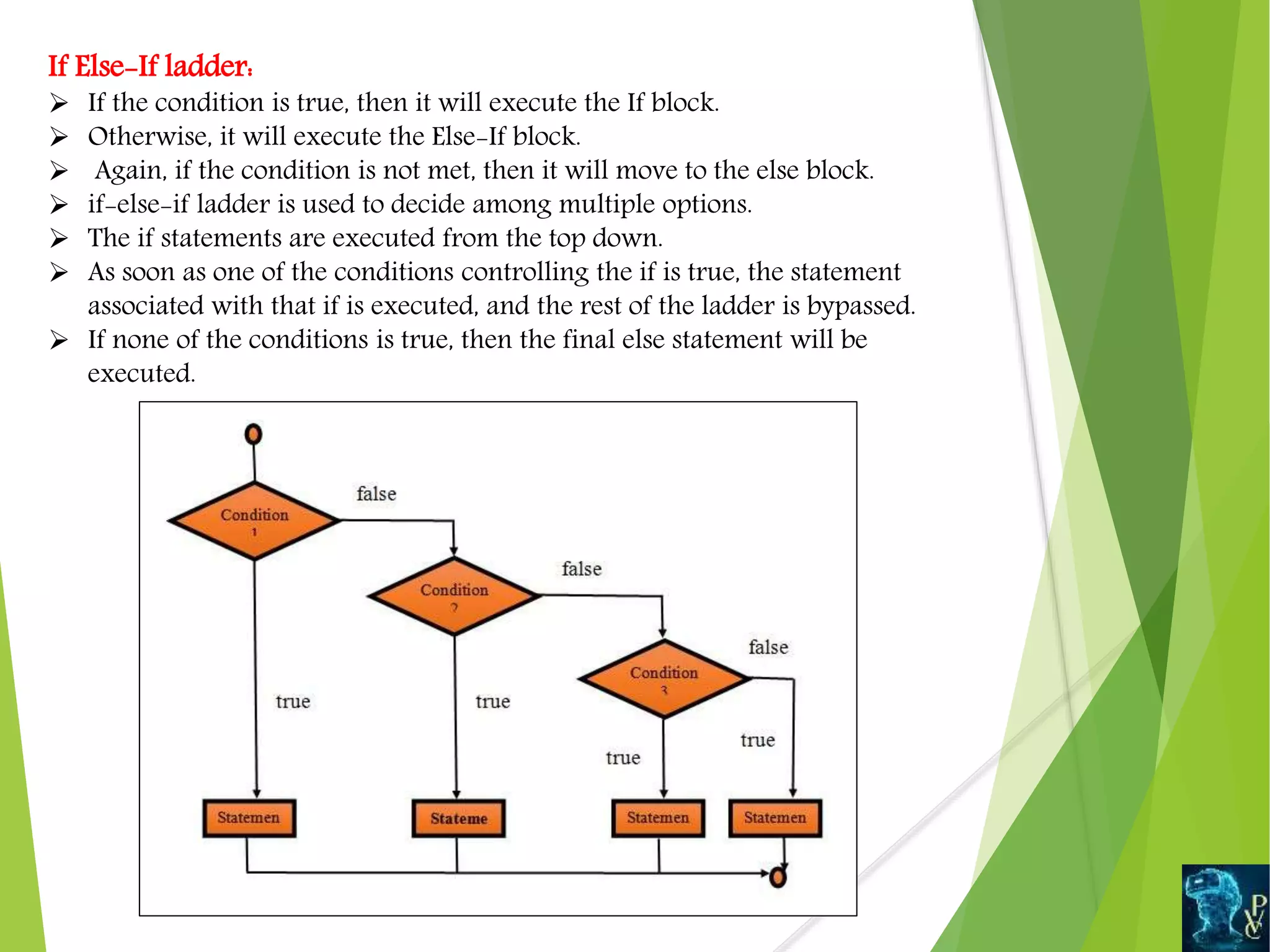

![Switch statement
The switch statement is a multiway branch statement.
A switch statement is used to execute a single statement from multiple conditions.
The switch statement can be used with short, byte, int, long, enum types, etc.
One or N number of case values can be specified for a switch expression.
Dulplicate case values are not allowed. A compile-time error is generated by the
compiler if unique values are not used.
The case value must be literal or constant. Variables are not permissible.
Usage of break statement is made to terminate the statement sequence. It is optional..
If this statement is not specified, the next case is executed.
Based on the argument in the switch statement suitable case value will be selected and
executed.
If no matching case found, then the default will be executed.
Switch(variable/value/expression){
Case :
// statements [];
Case :
// statements [];
…
default:
// statements [];
}](https://image.slidesharecdn.com/controlstmtsinjava-201023155146/75/Control-statements-in-java-12-2048.jpg)
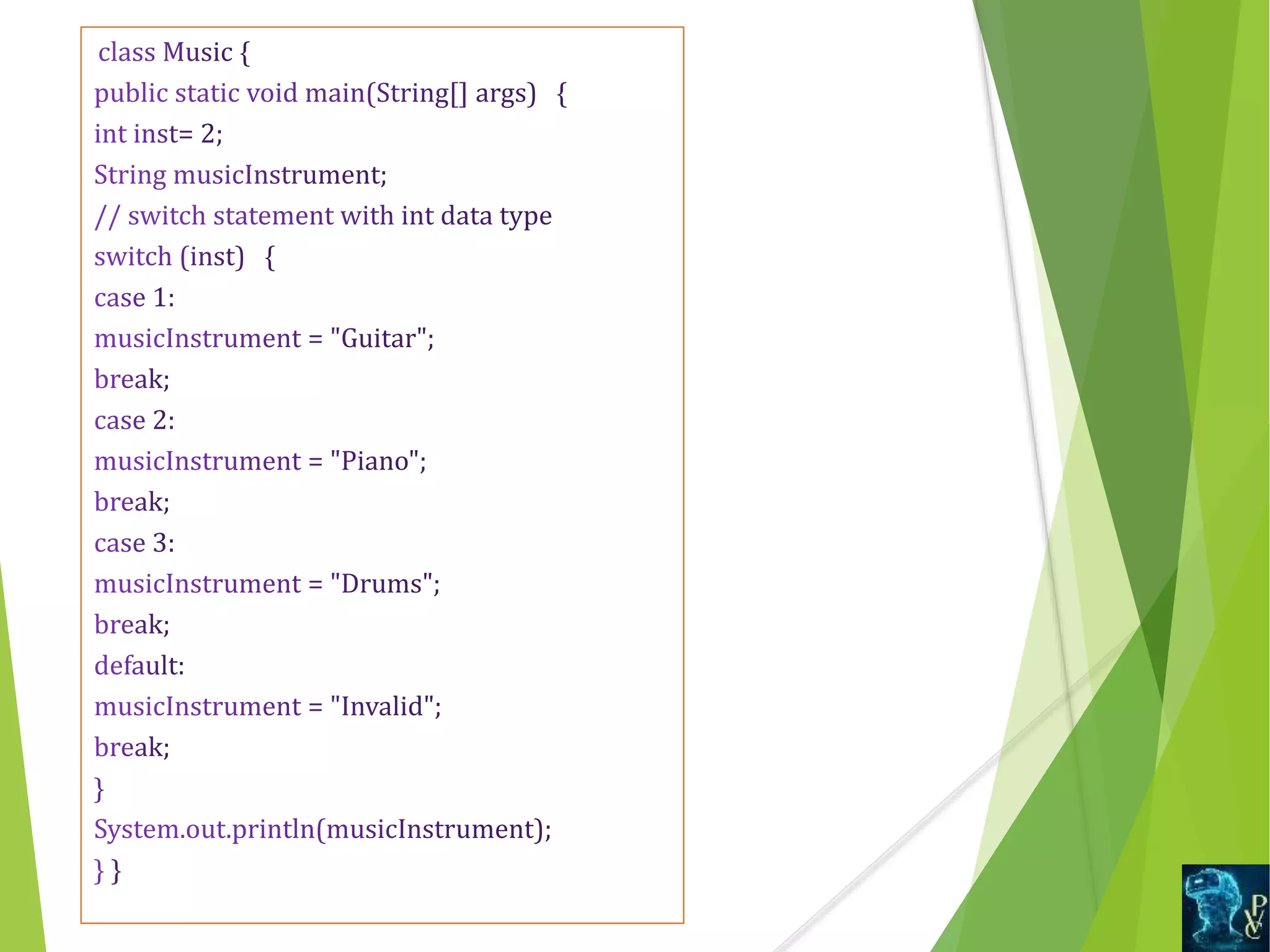
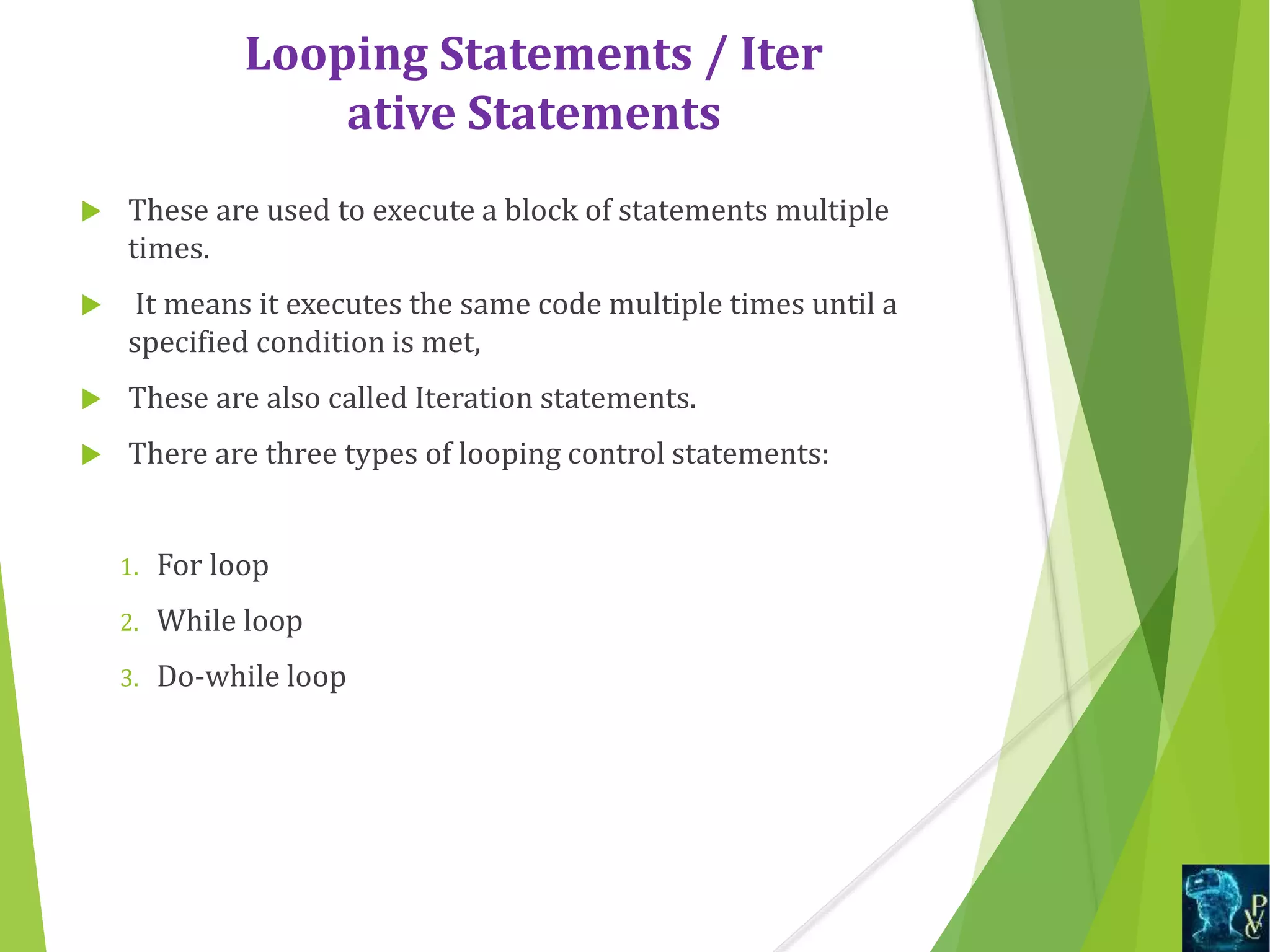

![class WhileDemo {
public static void main(String[] args) {
int i=1;
while(i<=10)
{
System.out.println(i);
i++;
}
} }
// Example for infinite while loop](https://image.slidesharecdn.com/controlstmtsinjava-201023155146/75/Control-statements-in-java-16-2048.jpg)
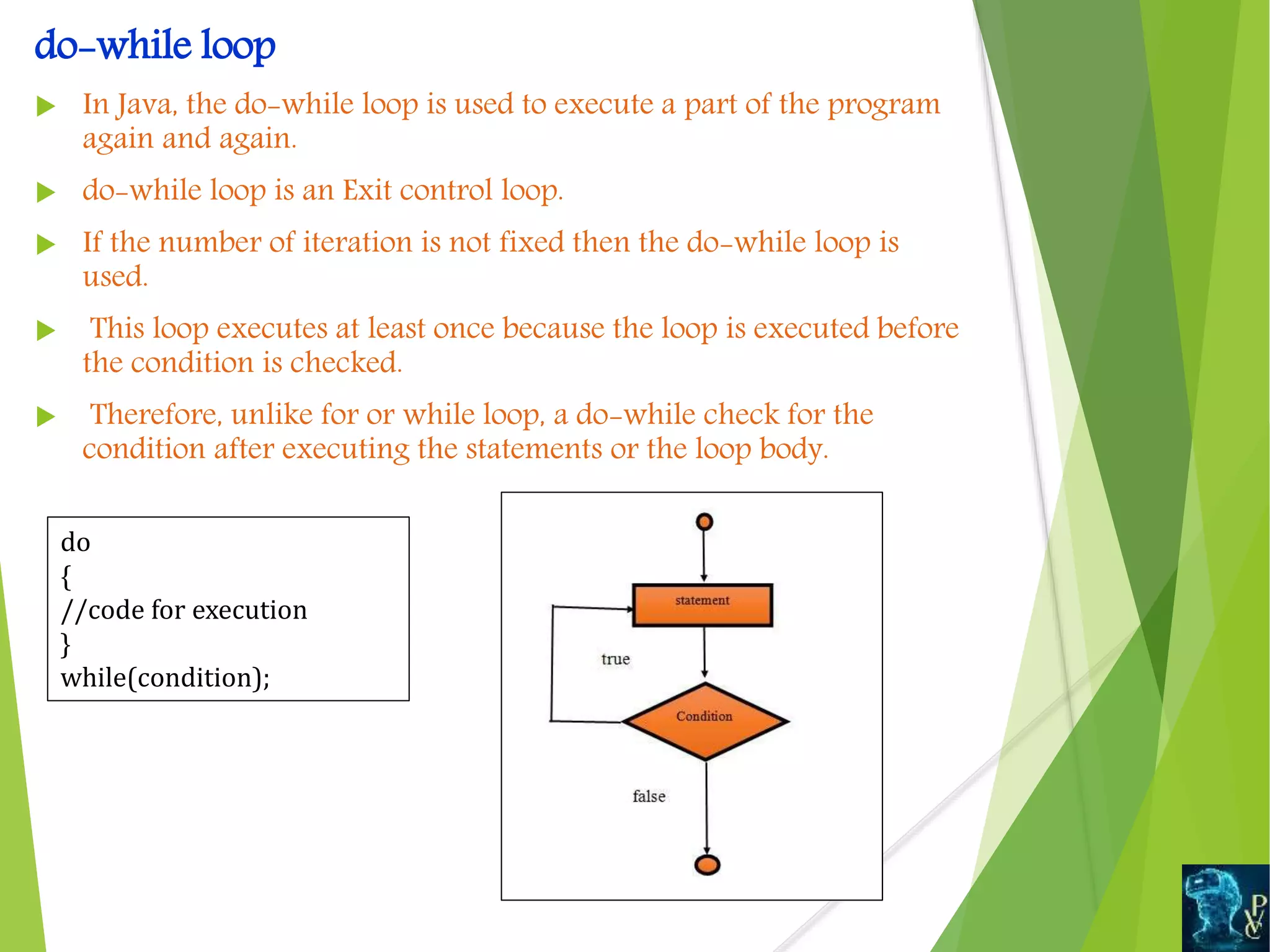
![// Program to display numbers 1 to 15 using do-while loop
class DoWhileDemo {
public static void main(String[] args) {
int i=1;
do {
System.out.println(i);
i++;
}while(i<=10);
} }
// Program for infinite do-while loop
class DoWhileDemoIn {
public static void main(String[] args)
{
do {
System.out.println("infinitive do while loop");
}while(true);
}
}](https://image.slidesharecdn.com/controlstmtsinjava-201023155146/75/Control-statements-in-java-18-2048.jpg)
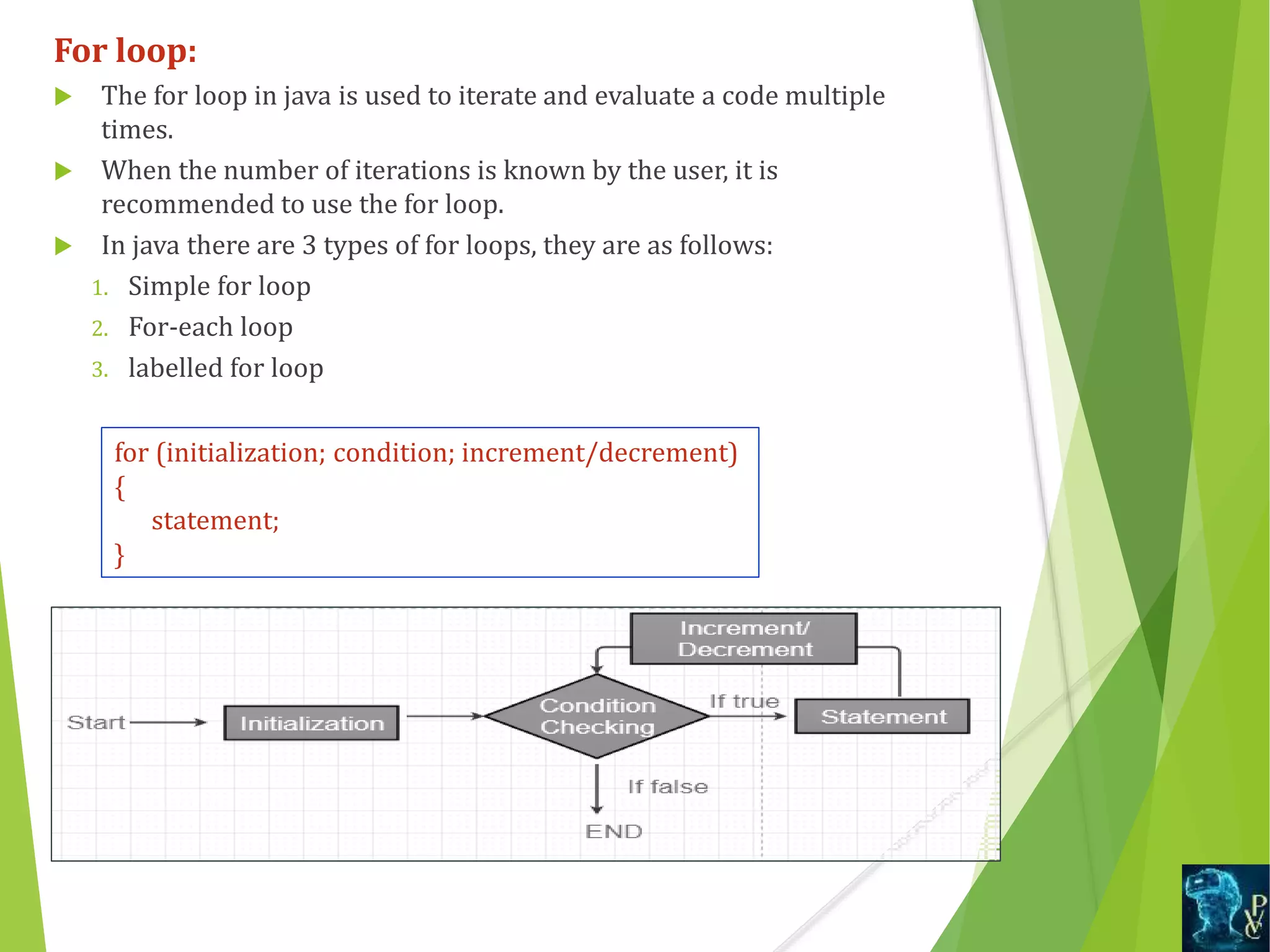
![// Java program to illustrate for loop
class forLoopDemo {
public static void main(String args[]) {
// Writing a for loop
// to print Hello World 5 times
for (int i = 1; i <= 5; i++)
System.out.println("Hello World");
} }
// Program to display multiplication table
class ForDemo1 {
public static void main(String[] args) {
int n, i;
n=2;
for(i=1;i<=10;i++)
{
System.out.println(n+"*"+i+"="+n*i);
}
} }
Output:
2*1=2
2*2=4
2*3=6
2*4=8
2*5=10
2*6=12
2*7=14
2*8=16
2*9=18
2*10=20
Output:
Hello World
Hello World
Hello World
Hello World
Hello World](https://image.slidesharecdn.com/controlstmtsinjava-201023155146/75/Control-statements-in-java-20-2048.jpg)
![For-Each loop:
The traversal of elements in an array can be done by the for-
each loop.
The elements present in the array are returned one by one.
It must be noted that the user does not have to increment the
value in the for-each loop.
for(Type var:array)
{
//code for execution
}
public class ForEachDemo1
{
public static void main(String[] args) {
inta[]={100,101,102,103,104};
for(int i:a)
{ System.out.println(i);
}
} }
Output:
100
101
102
103
104](https://image.slidesharecdn.com/controlstmtsinjava-201023155146/75/Control-statements-in-java-21-2048.jpg)
![Labelled For Loop
In Java, Labelled For Loop is used to give label before any
for loop. It is very useful for nesting for loop.
labelname:
for(initialization;condition;incr/decr)
{
//code for execution
}
public class LabeledForDemo {
public static void main(String[] args) {
num:
for(inti=1;i<=5;i++)
{
num1:
for(int j=1;j<=5;j++)
{ if(i==2&&j==2)
{
break num;
}
System.out.println(i+"
"+j);
} }
}
}
Output:
1 1
1 2
1 3
1 4
1 5
2 1](https://image.slidesharecdn.com/controlstmtsinjava-201023155146/75/Control-statements-in-java-22-2048.jpg)
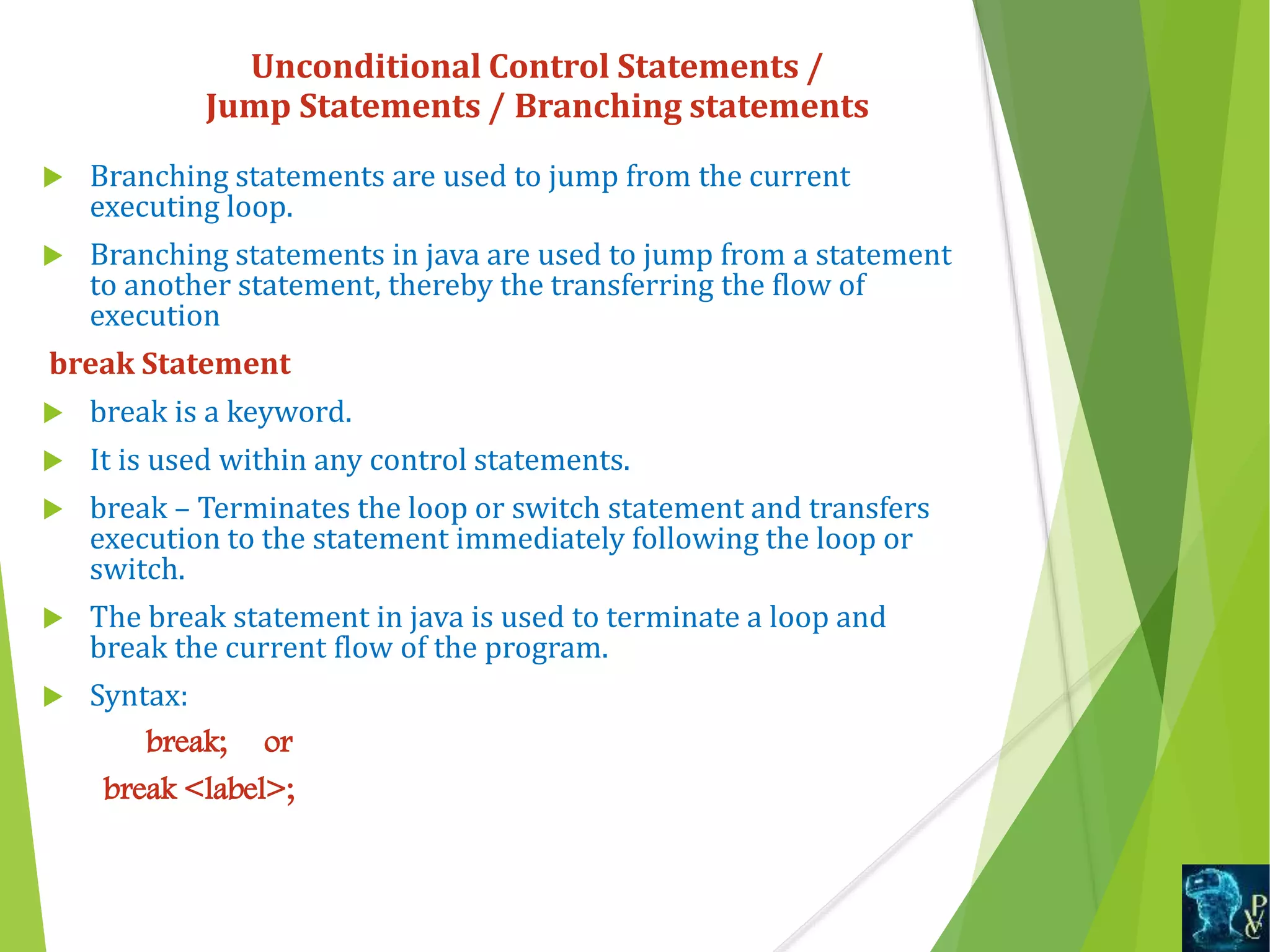
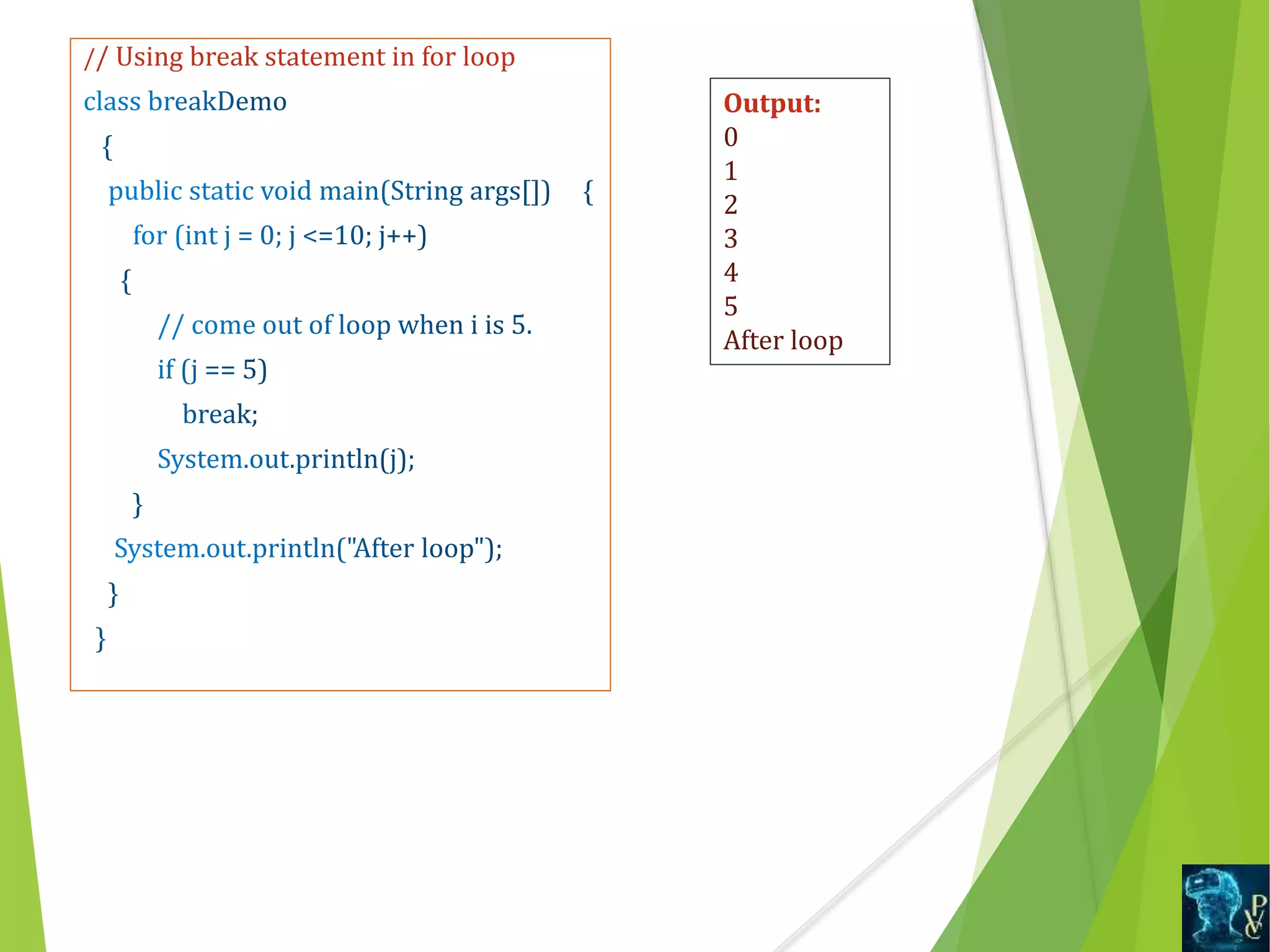
![continue Statement
continue is a keyword.
In Java, the Continue statement is used in loops.
Continue statement is used to jump to the next iteration of the loop
immediately.
It is used with for loop, while loop and do-while loop.
Syntax:
continue; or
continue<label>;
class continueTest {
public static void main(String args[]) {
for (int j = 0; j < 10; j++)
{
// If the number is odd then bypass and continue with next value
if (j%2 != 0)
continue;
// only even numbers will be printed
System.out.print(j + " ");
}
} }
Output: 0 2 4 6 8](https://image.slidesharecdn.com/controlstmtsinjava-201023155146/75/Control-statements-in-java-25-2048.jpg)
![//continue with label is used to continue the number of loops below
the label
class contlabelDemo{
public static void main(String args[]){
Termi:
for(int i=1;i<=4;i++)
{
for(int k=1;i<=4;k++)
{
System.out.print(“ ”+i+” ”);
if(i==3)
continue Termi;
System.out.println(“Hello”);
}
}
} }](https://image.slidesharecdn.com/controlstmtsinjava-201023155146/75/Control-statements-in-java-26-2048.jpg)
